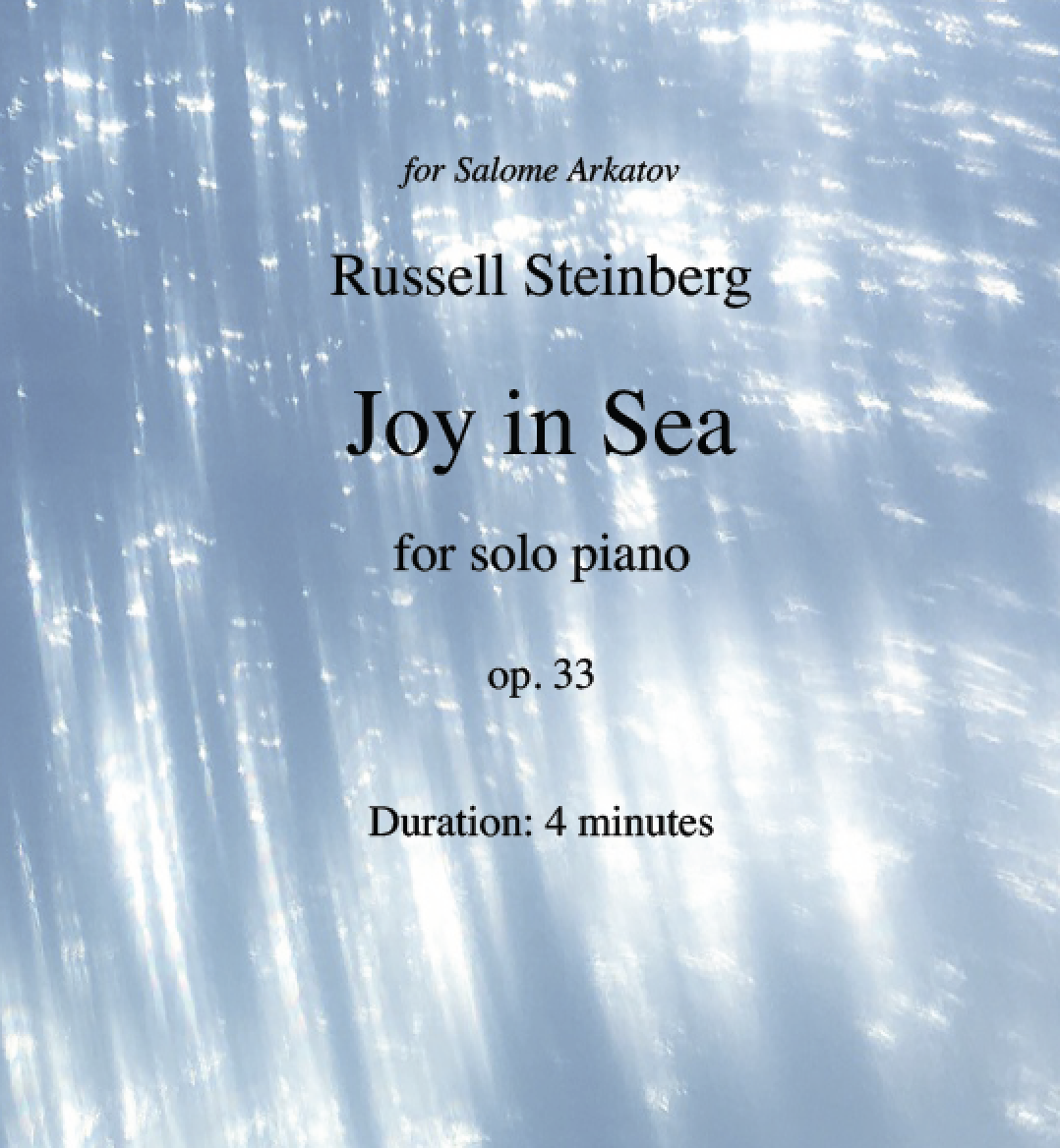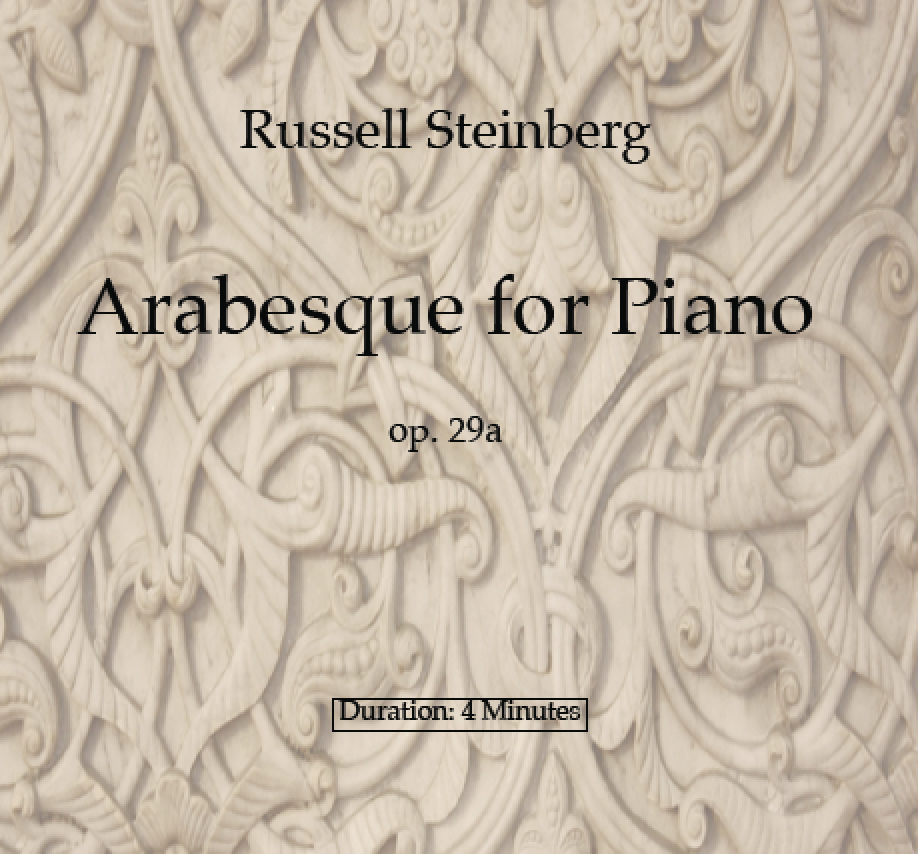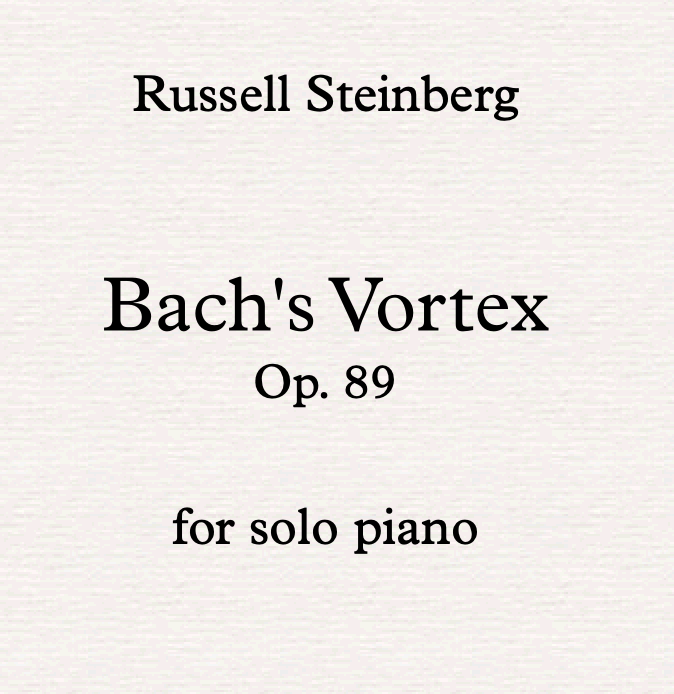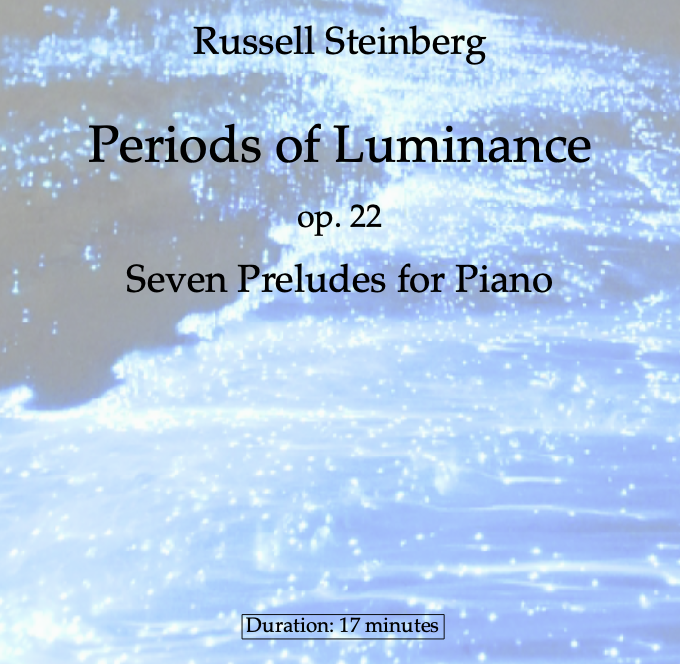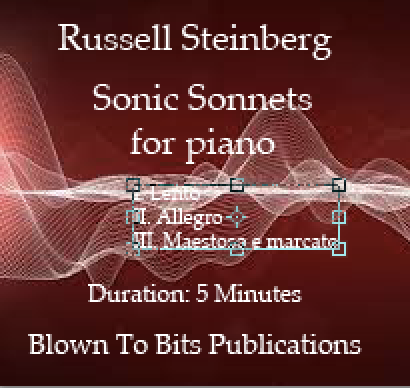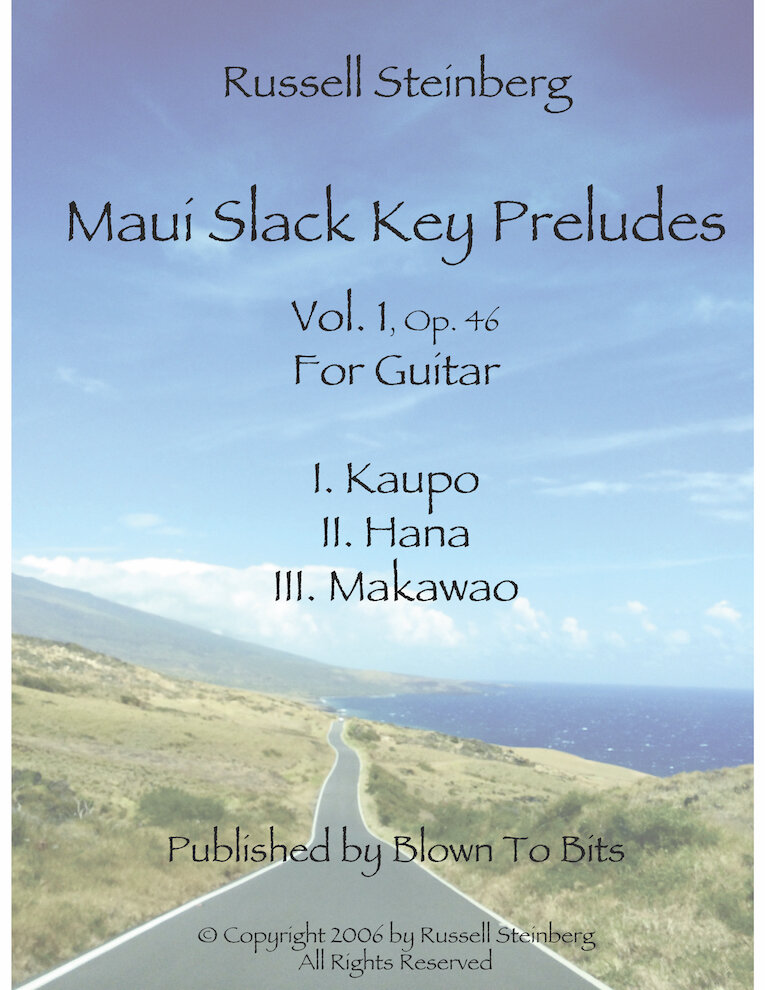SOLO MUSIC
PIANO
BEACH PEBBLES vol. 1, 2, 3
op. 65 a, b, c
Program Notes
Beach Pebbles are a large collection of character pieces composed in the spirit of Robert Schumann’s Kinderszenen or Felix Mendelssohn's numerous Songs Without Words. Some of them are truly simple, while others require an advanced technique. They are personal works that remind me of the small rocks I love to collect at the beach, where a certain pattern, color, or texture arrests attention to beauty, if only for a moment.
The 32 preludes are divided into three volumes.
Volume 1 (intermediate technique)
Volume 2 (intermediate to advanced technique)
Volume 3 (advanced technique)
Despite this division, the Pebbles may be played in any number or order that makes aesthetic and emotional sense.
VOLUME 1
1. Summer Dream
2. Sandpipers
3. Short Story
4. Sandcastle
5. Romance
6. Seagulls
7. Sailboats
8. Adrift
9. Child’s Play
VOLUME 2
1. Seabreeze
2. Lost Frontier
3. Music Box
4. Mazurka
5. Birds at Dusk
6. Beachcombing
7. Perotin's Aura
8. Autumn Brooding
9. Tidal Hymn I (Low Tide)
10. Fog
11. Prayer
12. Triad Dance
VOLUME 3
1. Prelude: Sea and Foam
2. Bodysurfing
3. Clouds
4. Harbor Seals
5. Aspen Brook
6. Deep Blue
7. Carefree
8. Tidal Hymn II
9. Grunion
10. Procession
11. Postlude: Foam and Sea
SEQUOIA SONATA (3 MOVEMENTS)
OP. 20
Duration: 20 minutes
Instrumentation: Solo Piano
Movements: 3
I. Andante Rubato
II. Muted and Expressive
III. Scherzo Vivace
Program Notes
Sequoia Piano Sonata
I. Andante Rubato
II. Muted and Expressive
III.Allegro
Steinberg's Piano Sonata had some of the same musculature as the big Romantic concertos, but with nothing "neo" or meretricious about it. To these ears the floating, luminous music of the middle movement was also the heart of the piece.
Boston Globe
A reviewer for the Boston Globe remarked on the "musculature" of this sonata. I guess that is part of what I had in mind when trying to evoke the spirit of the massive redwood trees in Sequoia National Park. Anyone who sees them is in awe of their massive root systems supporting trunks that taper into the heavens. The first movement is a world unto itself with a meaty length (about 12 minutes) built around the idea of a rising arpeggio and trills. In fits and starts, it gropes towards several moments of power. In contrast, a hazy glow of chords and quiet melodies imbue the second movement with a hovering sensation, as though we are suspended in the tops of the trees. A quick scherzo concludes the sonata, spitting out sharp chords and fanfares in an explosive rendition of material from both previous movements.
FOUR PIECES FOR PIANO
OP. 36
Duration: 10 minutes (complete—4 preludes)
Instrumentation: Solo Piano
Program Notes
These four tonal piano pieces make a short character suite: two lively pieces, a toccata and light-hearted bagatelle, frame two expressive pieces, a berceuse and intermezzo. Berceuse is a dreamy A flat major nod to Chopin’s masterwork of the same title. Intermezzo is a moodier lyrical work in a quasi-octatonic language.
1. Toccata
2. Berceuse
3. Intermezzo
4. Bagatelle
Desert Stars
OP. 38
Duration: 12 and a half minutes (3 movements)
Instrumentation: Solo Piano
Movements: 3
I. Swift, Soft, Pulsing
II. Freely, Straining To Hold Together
III. Gently
VIEW PREVIEW SCORE
Program Notes
Desert Stars is a set of three improvisatory fantasies that I conceived during nights stargazing in Death Valley. In the first movement, harmonies pulse and bleed together through the held piano pedal. A quasi lullaby is ripped apart in the second movement, unable to hold together in the vastness of space. The last movement is a gentle and nostalgic reinterpretation of the pulsing chords from the first prelude.
FLOATING PRELUDES
OP. 41
Duration: 8 minutes (complete—3 preludes)
Instrumentation: Solo Piano
Movements: 3
I. Clouds
II. Clocks
III. Elysium
Program Notes
All three Floating Preludes for Piano glow with an upper register resonance. The wispy phrases of “Clouds” unfold and float along in the extremes of high and low registers. Within the miniature world of "Clocks” is a kind of mad ticking that courses through an angry cosmos. "Elysium" is a nod to the special sonic worlds of French composer Maurice Ravel, but with my personal quiet treble resonances.
I. Clouds
2. Clocks
3. Elysium
AMAZING GRACE VARIATIONS
OP. 2
Duration: 6 minutes
Instrumentation: Solo Piano
Movements: Theme and Five Variations
Program Notes
Amazing Grace Variations was actually an undergraduate composition assignment to create stylistic variations on this famous hymn tune. The first variation inverts the tune (upside down) and places it in the style of an Erik Satie's Gymnopedie, the second variation sets the tune in an impressionist blues style, the third uses tone clusters alla Bartok, the fourth is atonal and spacy, and the fifth transforms the hymn into an Americana style chorale.
Amazing Grace Variations was an undergraduate assignment to compose stylistic variations on this famous American hymn tune. I still find it feels "good on the fingers" and is fun to play.
In the first variation, the melody isupside down in the style of Erik Satie's serene Gymnopedies.
The second variation sets the tune in an impressionist blues style.
Tone clusters alla Bartok accompany the tune in a plucky scherzo third variation.
The fourth variation is atonal and diesmbodied, the tune spanning the registers of the piano.
The fifth variation sets the hymn in an expressive Americana style chorale concluding with a reduction of the tune to quasi pentatonic wind chimes.
FIVE FINGER PIECEs (Easy)
OP. 35
Duration: 6 minutes (complete—4 short pieces)
Instrumentation: Solo Piano
Movements: 4
I. Aya
II. Robert
III. Jason
IV. Jim
Program Notes
Each piece places both hands in a particular "five finger" position and the hands remain in that position throughout. Five Finger Pieces for Piano is dedicated to four of my adult composition students—Aya, Robert, Jason, and Jim. Each brought an essential child's curiosity to learning and I composed brief and simple music to reflect that quality. Aya Sela from Israel was a natural teacher who reveled in discovering depth in simple things. Robert Spano was a master sound engineer for Paramount Studios who "for fun" built his own harpsichord and Pacific Northwestern canoe. I reflected his love for counterpoint and early music in the short piece I wrote for him. Jason was a mathematician whose vigorous energy became a presto of incessant eighth notes. The last piece, "Jim," is my shortest composition, a mere 20 measures. It refines the already simple opening Aya piece. Jim Bishop was a pure soul—extremely sensitive, tall, slender with long hair. He played bass guitar and yearned to know everything he could about music. He assisted me expertly with graphics and production on my books AudioMaps of the Beethoven Symphonies. Jim's life was cut tragically short in a freak winter accident when his brother lost control of a car on a highway in their hometown of Michigan and hit a tree, killing them both instantly. The world feels so diminished without him.
JOY IN SEA
Op. 33
Program Notes
Joy in Sea is an exuberant and playful piano prelude. The title is a pun on its tonal center (C) and inspirational origin: I had just moved near the ocean in Pacific Palisades, CA. It's motive —C-B-G—recurs in many of my pieces as a hazy C7 sonority that opens a door either to C major or B major.
ARABESQUE
Op. 29A
Duration: 4 minutes
Instrumentation: Solo Piano
Program Notes
The arches and ornaments of my Arabesque are inspired by two famous classical piano pieces of the same name, one by Robert Schumann and the other by Claude Debussy. Like both of those, mine is gently introspective. Imagine a lullaby under a canopy of stars. Its rocking motion begins in a modal language that gradually becomes more and more chromatic as it spirals ever upwards.
Careful use of the pedal is necessary both to add essential color but to maintain harmonic clarity.
Arabesque is also transcribed for chamber orchestra.
Water Rays
Op. 83
Duration: 10 minutes
Instrumentation: Piano
Movements (played without pause):
I. Aquamarine
II. Cyan
III. Deep Turquoise
Program Notes
Water Rays is inescapably post-impressionistic, with clear References to Debussy and Ravel. I am fascinated with the patterns of light rays below water that we see in pools or shallow lagoons. The dynamic motion of these rays make a sublime dance. While trying to imagine a sonic analogue on the piano, I noticed that holding the pedal down, letting simple sonorities ring, creates a beating of the sound waves with their own complex dance of collisions and bounces, much like the light rays on water. I begin Water Rays just like that—very minimally and quietly with a major chord decorated diatonically (with other notes of the scale). The overtones above these simple sounds create an elaborate dance high above, almost higher than you can hear. The piece evolves by using trills to both increase the energy and play with these higher resonances in ever higher transcendent plateaus. Water Rays has three sections, played without pause, each dedicated to a different harmonic color: aquamarine (F “majorish”), cyan (D “majorish”), and deep turquoise (B “majorish”).
STAR WHEELS
Op.67
Live performance of Star Wheels at Zipper Concert Hall, Los Angeles
Duration: 12 minutes, one movement
Instrumentation: Solo Piano
Program Notes
Star Wheels imagines different collections of modal scales interacting as celestial spheres. Dynamics and articulation distinguish the different "spheres" to help the ear intuit how they cross and combine.
Liberal use of pedal and resonance establish auras of color for each six note pitch collection and transform the arpeggios into chordal textures. Pianists should feel free to add or take away pedal in order to enhance particular effects and ensure that the music does not become obscured. Color and beauty of tone are critical.
Tempo should have an improvisatory sense of discovery, while adhering to the general markings in the score. Within those markings, I encourage the performer to explore ad libitum governed by taste and overall effect.
BACH’S VORTEX
Op. 89
Pianist Lisa Weiss performs Bach’s Vortex with dancer Jesse Keller
Duration: 4 Minutes
Instrumentation: Solo Piano
Note: Score includes reduction sketches of the final measures of Bach’s Fugue in B minor WTC II
Program Notes
Not infrequently, moments in Bach's music ascends to the "nose-bleed" limit of tonality. Bach understood tonality so deeply that he was able to bend it just to the breaking point and then "return to Earth" with a sudden cadence of clarity or recognizable sequence of 5ths. But those moments "in the cracks" between key areas are quite phenomenal. They sound like portals to music written hundreds of years later.
Bach was keenly aware of what he was doing! It can't be an accident that the final section in the final fugue of the second volume of the Well Tempered Clavier includes one of these remarkable moments. It's as if Bach wanted to send off this lavish compendium of preludes and fugues that traverse all the tonal keys with a statement that there lies far more beyond!
In this dense, but brief and dissonant passage, I hear intimations of both Wagner and Schoenberg. I conceived of creating a short piece that would expand these handful of measures with their crazy cross relations in such a way as to make these "sounds of the future" apparent. I begin by carving away most of the notes to expose the bare-bone structure of dissonance that hovers over the entire passage. That sounds even farther than Schoenberg—all the way to Anton Webern. Then I gradually fill in Bach's actual pitches and increase the tempo until halfway through, the actual Bach passage sounds like a whirling dervish. Logically, the second half of the piece takes notes away again until the piece sounds as it began, but with a surprise ending that quotes Schoenberg's opening to his op. 11 piano pieces. By now, Schoenberg's style feels completely organic with the rest of the piece. Only "we are no longer in Kansas."
FLAG OF 9-11
PERIODS OF LUMINANCE
Op. 22
Duration: 17 minutes
Instrumentation: Piano
Movements: 7
1. Oceanic Lights
2. Lonely Sea
3. Lumentanz
4. Apprehension
5. Water Frolic
6. Turquoisence
7. Phosphur Trails
NOTES
PERIODS OF LUMINANCE... are seven piano preludes that draw inspiration from the mysterious flashing oceanic lights produced by phosphorescent algae. The term ‘bioluminescence’ doesn’t begin to capture the beauty of this nocturnal phenomenon. It is as if secrets of the universe briefly reveal themselves, only to dissolve back into the deep before we can fully grasp them.
Originally composed in 1991 and revised 2023
SMALL RAIN
Op.25
Duration: 11 minutes
Instrumentation: Solo Piano
Movements: 3
1. Drizzle
2. Raindrops
3. Sun Shower
The title Small Rain comes from the anonymous Medieval poem Western Wind that includes the phrase, “The small rain down can rain?” A gentle, nurturing, and replenishing rain for the spirit informs three movements of quiet and pretty luminance, inspired throughout by the insistent pulse in Chopin’s Raindrop prelude. A focus on beautiful tone quality and pedaling will reveal the luminous qualities of the piano. Enjoyable to play
ORGAN-AUM
OP. 51a,B
Duration: 8 minutes
Instrumentation: Organ or Piano
Program Notes
Organ-Aum, in a phrase, is "Perotin meets Fusion Rock." Much of the music is a playful contrast between the energy of the antique and the energy of pop music (though very much "classicized"). The title is naturally a pun on "organum" and anyone acquainted with the harmony in 12th century composer Perotin's stunning organum quadruplum such as Sederunt Principes or Viderunt Omnes will know precisely what I am after in terms of glowing sonority. The "aum" part of the pun is the idea of spiritual transcendence represented in an ascending scale. The piece opens with this scale and draws all of its energy in a sense from that burst of rhythm
and harmony.
Registrations and colors are left to the discretion of the organist because the nature of each instrument will require a completely different approach to insure the balance of powerful sonority with clarity of line. I've used descriptive titles such as "distant chant" or "quasi birdcalls" to serve as a guideline.
The piano transcription uses the sostenuto pedal to substitute for the pedal manual drones. Conventional pedaling should be used liberally along with the sostenuto pedal to create the best blend of harmonies while not obscuring the chord changes.
Organ-Aum was commissioned by organist Hans-Joachim Dumeier who premiered it in July 2005 for the Colorado College New Music Festival in Colorado Springs. A susbstantial revision was completed April 2010.
SONIC SONNETS
Op. 4
Duration: 5 Minutes
Instrumentation: Solo Piano
Movements (3):
I Lento
II Allegro
III Maestoso e marcato
Program Notes
Sonic Sonnets are three short rhapsodic pieces for piano I composed as an undergraduate at UCLA. They reflect my early impressions of Bartok and Prokofiev. When I entered the New England Conservatory, professor/composer Arthur Berger listened to play my music at my first lesson and wondered aloud why I had been accepted into the Masters program. At last I played these three pieces and he said he guessed there might be something there that showed some small talent.It’s interesting for me now to hear harmonies and gestures in these short pieces that I continue to explore in my works.
SPECTRAL RHAPSODY
Op. 56
ATONAL VARIATIONS
Op. 5
Duration: 12 Minutes
Instrumentation: Piano
Movements: Theme and Six Variations
Program Notes
In my studies at the New England Conservatory, Arthur Berger plunged me into his language of hexachordal atonality that was his synthesis of Milton Babbitt’s synthesis of Anton Webern. These variations were my first successful experiment. Avoiding triads and learning a new sensitivity to register, I discovered, for me, a new spectrum of harmony and color. The student pianist who premiered these variations (Michael Kamen) startled me afterwards when he fervently related this piece finally helped him appreciate contemporary music!
DICHROISMS: THREE PIECES FOR PIANO
Op. 6
Duration: 7 minutes
Instrumentation: Piano
Movements:
I. Lively and rhapsodic
II. Suspended and sustained
III. Fast and fragmented
Program Notes
Originally titled “Spatterings,” this was a secret protest piece I wrote while studying with Arthur Berger at the New England Conservatory. He had been training me in atonal composition for two years, where we would labor in lessons over every pitch to avoid any possible tonal reference. That actually is an art form in itself! But I had had it. I decided to make a point a composing a piece by picking pitches at random out of a paper bag, to see if he could tell the difference.
He was thrilled with the piece, saying it was the best work I had done, but just please come up with a better title. That night I headed to the dictionary to find the most objective, meaningless word possible. Several hours later I stumbled on ‘dichroism’—“the property of exhibiting different colors.” I never revealed my “top secret” method. Since Berger was not able to distinguish random pitches from the excruciating calculated pitch choices we struggled with in my lessons, I thought I exposed a fatal flaw in atonal music. I myself didn’t even like the piece and I told him I was determined to go back to tonal composition. He said if I did, I was destroying my career and that we wouldn’t speak again. And that was sadly exactly what happened.
Looking/listening back, I realize that the random pitch process in Dichroisms freed me to explore rhythm and texture more freely. By removing ego and emotion from the equation, I had “finally” composed a 20th century piece, removed from 19th century reference. I have no regret about the choice I made to abandon pure atonality, but I now hear and enjoy special moments in Dichroisms With the passing years, I now appreciate the discipline Berger inculcated in me for careful pitch and harmony. That was a gift, even if we were never able to come to aesthetic agreement.
CLASSICAL GUITAR
MAUI SLACK KEY PRELUDES VOL. 1 AND 2
OP. 46, 69
Duration: vol.1—8 minutes, vol.2—20 minutes
Instrumentation: Solo Guitar with Wahine Tuning (low E string tuned to C; low A string tuned to G)
Movements:
Vol. 1—Kaupo, Hana, Makawao
Vol. 2—Plumeria, Kula, Paia, Nahiku Beach, Swinging Bridges, Silversword, Kihei, Blue Pool
Maui Slack Key Vol. 1 Audio
Maui Slack Key Vol. 2 Audio
Program Notes
These are "classicized" slack key pieces. They fuse the essence of the Hawaiian tradition's deep resonance, nostalgia, and undulating tonic-dominant harmonies (like ocean waves!) with classical Spanish guitar. They differ from "proper"slack key guitar pieces, both in style and tuning. For instance, traditional Hawaiian slack key C Wahine tuning is C-G-D-G-B-D but most of my pieces tune down just the lower two strings, producing C-G-D-G-B-E (a C major ninth chord).
These preludes should be performed in a relaxed style producing deep soundsin the bass and a full singing melody in the treble. I have specified string numbers and barred passages throughout to make clear where everything is to be fingered on the guitar. Harmonics are sometimes marked with small circles, but many other times notated with diamond notes and specified frets
and strings.
The special serenity and nostalgia that characterizes Hawaiian slack key guitar is immediate even for first time listeners. With its European roots, simple harmony, sheer beauty of sound (loosening the guitar's lower strings to give them "slack"), this is music emotionally available to anyone, without special knowledge or familiarity with its traditions. That openness I find to be the magical root of Hawaiian culture.
My Maui Slack Key Preludes reflect my desire to recapture the special relaxed aloha that one feels immediately upon arriving on the island of Maui. Kaupo is inspired by the spectacular arid ranchland on the southwestern tip of the island. It is home to cattle, horses, and stirring vistas of mountain and ocean. Just around the parched landscape of Kaupo is Hana, the wettest lush tropical area of Maui, famed
for its beautyand special tranquility. My Hana prelude was written in memory of Dr. Laurie Bottoms,a writer and educator whose calm, nurturing inspired me as a teacher. Makawao is"upcountry" Maui, a town originally famed for its ranchland and paniolos (Hawaiian cowboys). Slack key guitar was in fact first created by Hawaiian paniolos in the 19th century. Today Makawao has a vibrant arts community and...many chickens and roosters roaming the streets! The harmonics and trills in this prelude capture the delightful energy of this locale.
FIVE PRELUDES FOR GUITAR
OP. 34
Duration: 12 minutes (complete—5 preludes)
Instrumentation: Solo Guitar
Movements:
1 . Misterio
2. Daffodils
3. Serenade
4 Harmonics
5. Waltz
Program Notes
The Five Preludes for Guitar are romantic pieces for classical guitar, clearly influenced by my affection for the 19th, early 20th century repertoire that legendary guitarist Andrés Segovia made so popular in his concerts. The first is a short, soft soliloquy of yearning. The gentle second prelude, "Daffodils," is dedicated to a next door neighbor, Karen Whalen, who confided that one night my music had turned her from suicidal thoughts. The third is a romantic prelude in G major. The fourth is played entirely with natural harmonics (the left hand fingers only touch the strings lightly without pressing down to create bell-like sounds). The fifth is a lighthearted waltz.
Prelude #1
Prelude #2 "Daffodils"
Prelude #3 in G
Prelude #4 "Harmonics"
Prelude #5 "Waltz"
VIOLIN
WHITE CRANE STUDY
OP. 21
Duration: 9 minutes
Instrumentation: Solo Violin
Movements: Sonata for Solo Violin in Four Continuous Movements
I.Striving
II. Scherzando
III. Andante Lontano
IV. Allegro
Program Notes
White Crane Study began as a short character piece for the violin which was to evoke some of the extraordinary qualities of the crane, a bird that inspired a famous style of Chinese martial arts (Pai Huo). Though relatively small and unaggressive, the crane can generate sufficient energy through its powerful wings to break branches, maintain balance in even the strongest winds, and emit a high, piercing cry which carries for miles.
My materials quickly unfurled in unexpected directions and I found myself writing a much larger work. The piece generates energy with powerful rhythmic gestures and a variety of effects which extend the string sonority in many directions, some quite "birdlike" incidentally. The first movement is characterized by a 'growing' energy, ascending in flight if you will. Once a high pinnacle is achieved, a transition leads to a scherzo originally conceived as a battle between the crane and a snake. The third movement is a slow reflection of previous motives , especially a tremolo which resembles distant crane calls. After an eerie slide down the entire length of the violin's D string, these tremolos rebuild energy to a vigorous recapitulation of the opening melody in the brilliant final movement.
MAROON BELLS
OP. 63
NOT YET PREMIERED
Duration: 12 minutes (4 movements)
Instrumentation: Solo Violin (or Viola or Cello)
CELLO
CELLO TROPES
OP. 49
Duration: 16 minutes
Instrumentation: Solo Cello
Movements: 4 continuous movements
I. Allegro Cantabile
II. L'istesso Tempo, but more freely
III. Scherzando
IV. Presto ("Appalachia meets the Synagogue")
Program Notes
Cello Tropes is an extended sonata for unaccompanied cello in which an evocation of synagogue chant embarks on a series of variations that ultimately transforms it into Appalachian-style fiddling.
Cello Tropes was begun in Tel Aviv as part of a grant from the Center for Jewish Culture and Creativity founded by John Rauch. The piece grew from a suggestion from composer Joseph Dorfman (then the director of the Rubin Academy of Music at Tel Aviv University) to explore the cells of cantorial music in the context of a solo instrumental work. With great passion, Dorfman described how the great cantors in Jewish tradition were star performers not any different from today's classical virtuosos. He felt that Jewish tropes deserved highly virtuosic settings, which he himself did masterfully in his own solo violin and cello works.
I became interested in the cells from "Onochi Adonoy," a complex cantorial prayer that is part of the Anthology of Jewish Music by Chenjo Vinauer (published by Edward Marks Corp. in 1953). I was particularly struck with the sense of developing variation in this prayer, as well as its haunting and folk-like pentatonic quality. I began to imagine a cello representing the Chazzan, first intoning a dark and lyrical prayer, but finally culminating in a joyous music that suggests the flavor of fiddling tunes. I suppose this vision represents my "American" perspective to these ancient chants. The piece is actually written in four movements, but with no break in continuity between the sections.
Cello Tropes is dedicated to Professor Joseph Dorfman, who coached me extensively on revisions of the piece while visiting Los Angeles in 2006. It was premiered by Armen Ksajikian in Los Angeles. Richard Slavich performed it in Colorado. Yorika Morita performed it in Wisconsin.
TITAN’S DEPTHS
op. 87
NOT YET PREMIERED
Duration: 8 minutes
Instrumentation: Solo Cello
Movements: 3
I. Lament of Lakes and Seas
II. Methanian Dance
III. Depths of Kraken Mare
Program Notes
Some background on Titan...
Titan is Saturn’s largest moon and the Cassini probe revealed that it is the only other body in the solar system other than Earth to have lakes and seas on its surface. Instead of water, they are filled with liquid methane and ethene. Kraken Mare is Titan's largest sea, and larger than Earth's largest inland water body, the Caspian Sea. It's depth is unknown, but could be as deep as 1,000 ft. Besides its clouds, rain, lakes and rivers, Titan mimics Earth in other ways as well, with a rich atmosphere (nitrogen) and a landscape that looks familiar yet is formed by different chemical processes due to its extremely cold temperature (-290 degrees Fahrenheit).
Titan's Depths for solo cello is in three movements:
I. Lament of Lakes and Seas (Andantino con l'anima)
II. Methanian Dance (Allegro scherzando)
III. Depths of Kraken Mare (Adagio solitario)
The piece is an emotional response imagining Saturn's moon—its beauty, its mystery, and its loneliness, lonely in the sense that it mimics so much that is earthly-familiar, yet ultimately completely alien. The first movement should be played freely, dramatically, and melodically expressive. The second movement dance is vigorous and rhythmic. The low arpeggios when played at tempo should sound chordal. The pizzicati can have some degree of snap if desired. The last movement should be atmospheric. The high artificial harmonics should sound distant, but also clear. The cantabile and appassionata phrases should be sound closer and warmer. The flautando e rubato section should be played freely, with a sense of breath between the phrases.
CLARINET
Clarinet sonata (solo)
OP. 64
NOT YET PREMIERED
Duration: 9 minutes (4 movements)
Instrumentation: Solo Clarinet
Movements:
I. Soliloquy
II. Iterations
III. Longing
IV. Humoresque
Program Notes
This solo sonata contrasts two slow lyrical movements—Soliloquy and Longing—with two quicker, angular, light-hearted pieces—Iterations and Humoresque. The focus of this sonata is the clarinet’s wide dynamic range and remarkable color differences between its different registers.



